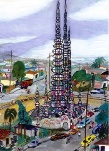It’s a compelling story. For one, it’s
unusual for any American novel, let alone
one meant for kids, to emphasize the
under-told story of everyday Italians in
California. Second, it offers a series of
details, couched in terms accessible to a
child, about how Italian immigrants
negotiated their entrance into US life,
suggesting ways new immigrants sometimes
ignored or refigured assimilationist
pressures.
Angelo (1897-1982) emigrated as a child from
Massarosa (Tuscany) in 1905 and his family
eventually settled in the town of Antioch,
not far from San Francisco. He held a number
of manual labor and factory jobs in and
around Antioch, and later in San Francisco,
until he landed a job at a photo-engraving
shop in the city. It was there that he
realized he had an artist’s mind. He wrote a
number of children’s novels—Golden Gate
is part of a series that feature Italian
kids and take place both in the U.S. and in
Italy. Angelo’s real calling, however, was
as a book illustrator and engraver.
Golden Gate (title page)
(The Viking Press, 1939)
John Fante's Dago Red (1940),
Cover by Valenti Angelo
(picture courtesy of Stephen Cooper)
He preferred linoleum (linocuts) to wood
in creating his engravings, and he
worked on all kinds of books; his work
helped establish the stark, geometrical
aesthetic we now recognize as distinctly
midcentury.
"Subway Entrance, New York City"
(1969)
"Christ" (date unknown)
The novel itself feels a bit dated, at least
for a cookies-and-juice crowd: excessive
description; old-fashioned word choice;
questionable depictions of Native Americans.
But at the same time it’s surprisingly fresh
and contemporary in a number of ways. For
starters, there is more than a passing
reference to Nino’s immigrant neighbors,
mostly Irish and Chinese families. And the
narrative shares a particular Italian
American sensibility that I found to be
downright revealing.
When Nino and his grandfather gather clay
and stones around their farm and build
Nino’s mother an outdoor oven so she can
bake bread—“just like the bread back home in
the village” (101)—I couldn’t help but
notice how the novel shows Italian immigrant
place-making. Before the oven gets used,
Nino carves a rooster out of clay and fixes
it on the oven as a decorative touch and as
a reminder of a similar rooster he had back
in Italy. In fact, when my son asked me why
Nino had done that, realizing that the
rooster had nothing to do with the utility
of the oven, I had to refrain from starting
a lecture on Italian American folk art (it
took all my energy not to gather up our
things and drive him out to Fresno to see
the Underground Gardens right then and
there).
Likewise, when Nino goes to school for the
first time, Angelo characterizes how the boy
might have stood out—with his broken
English, the wine be brought with his lunch,
and his odd clothing (he goes to school
wearing a smock—the classic Italian
grembiulino kids still wear to school
today— rather than the overalls the other
boys were wearing).
Cover of Nino (1938), the first
novel in the series,
with protagonist in obligatory
grembiulino
It’s very much a boy’s story, and we see
everything through Nino’s eyes. And of
course I would have liked to have heard more
about his mother, Allinda, or his baby
sister, Gloria, whom she gives birth to
under less-than-ideal circumstances.
Certainly, too, I have to wonder what kind
of readers would have picked up the novel in
1939, just before Italy and the US went to
war, and what kinds of lessons were taken
away about Italian Americans. Nevertheless,
today it remains an interesting example of
how books meant for children also play a
part in shaping what it means to be Italian
in the United States.






